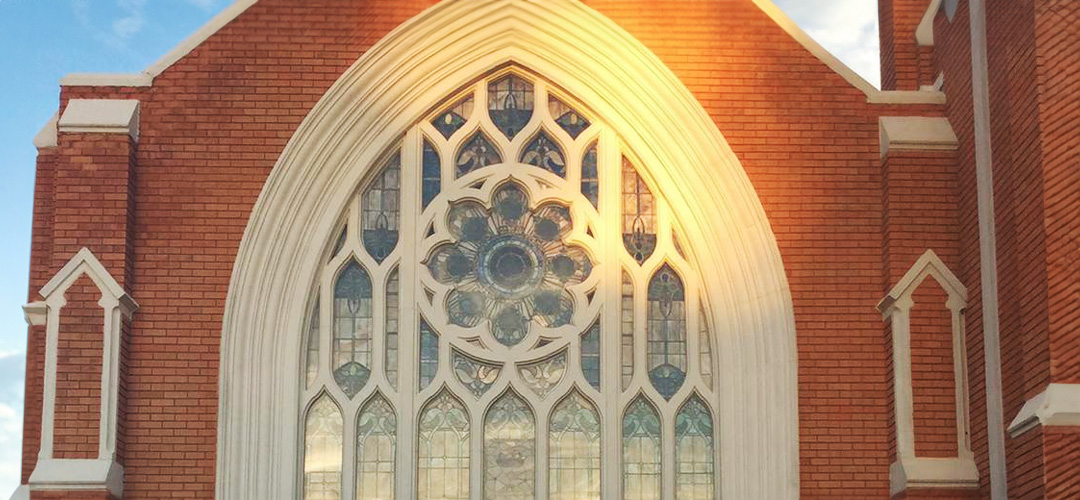
The ethereal beauty of antique stained glass windows is one of the most captivating features of historic churches. These vibrant panes do more than adorn sacred spaces; they tell stories, evoke spirituality, and preserve centuries of craftsmanship. Yet, as time takes its toll, preserving these remarkable works of art becomes a responsibility for church leaders and conservationists alike.
This guide explores how to protect, repair, and restore antique stained glass windows, addressing threats, sharing preventative measures, and guiding you toward ethical restoration practices. Whether you’re a church steward or a historic preservation enthusiast, you’ll learn how to ensure these treasures endure for future generations.
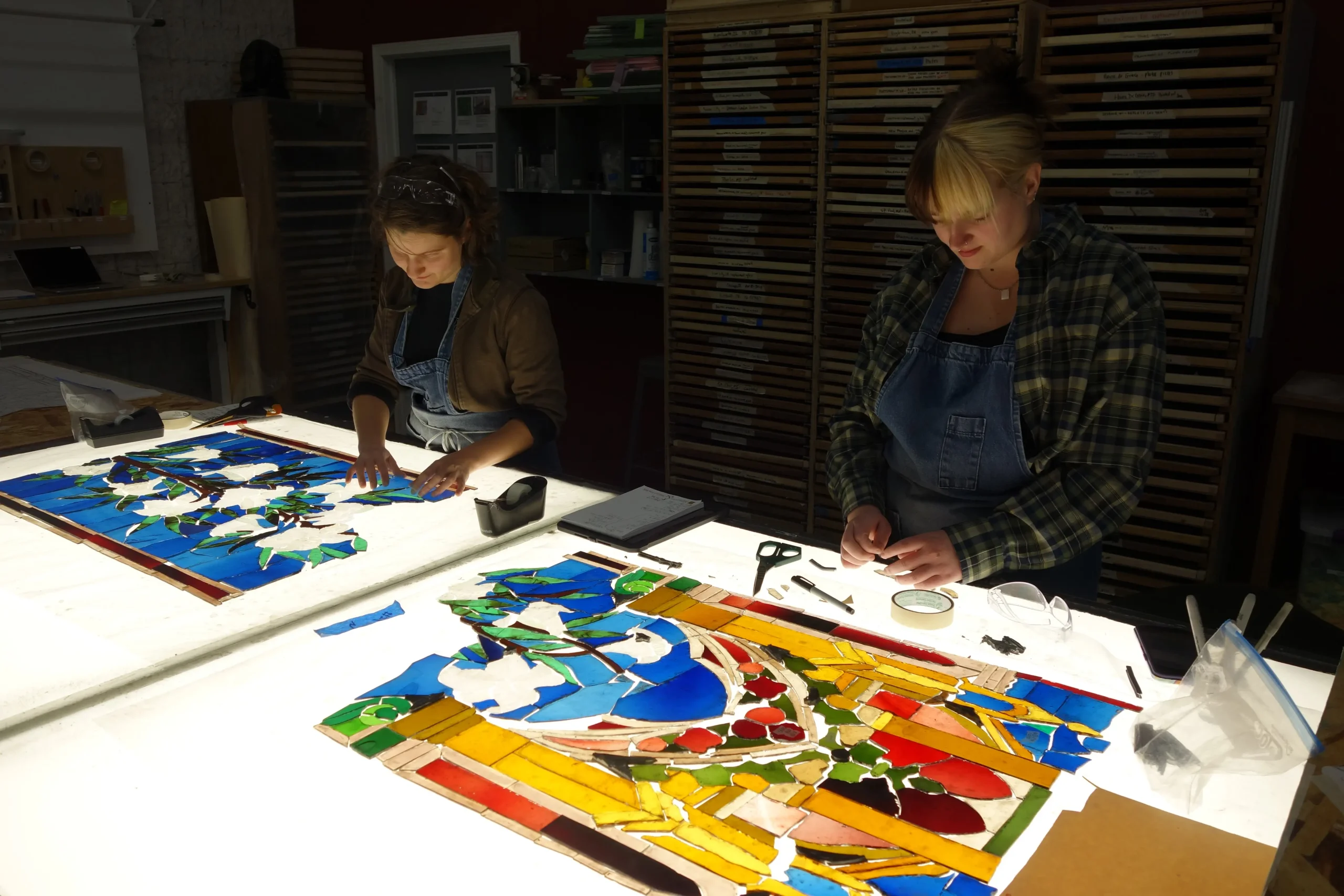
Understanding the Threats to Antique Stained Glass
Antique stained glass, with its intricate design and delicate craftsmanship, faces numerous repair challenges that threaten its longevity. Properly understanding these threats is crucial for implementing effective preservation and restoration strategies. These challenges primarily fall into three key areas: environmental factors, human interference, and neglect. Each of these elements, if left unaddressed, has the potential to cause irreversible damage to these priceless treasures.
Environmental Factors
The natural environment poses one of the greatest challenges to the preservation and repair of antique stained glass, as it is perpetually exposed to the elements. Prolonged exposure to ultraviolet (UV) rays from direct sunlight can fade the vivid colors that make antique stained glass so distinctive. Over time, this bleaching effect can strip panels of their vibrancy and artistic intent.
Temperature changes also exert long-term stress on stained glass installations. Fluctuations between warm and cold conditions can cause the expansion and contraction of both the lead cames (the metal support structure holding glass pieces together) and the glass itself. This process weakens the structural integrity of the entire window, resulting in cracks, loose sections, or warped frames.
Additionally, wind-driven debris, heavy precipitation, and hailstorms can physically damage fragile glass surfaces. The protective properties of the surrounding stone or wooden frames may deteriorate, allowing rainwater to infiltrate and contribute to internal damage. Moisture accumulation is of particular concern, as repeated exposure to rain or condensation often leads to corrosion of the lead cames. Over time, the gradual disintegration of these critical supports can result in sagging, bowed panels, or worse, complete collapse. Without mitigation and proper repair, these environmental stressors create a slow but relentless process of decay on your antique stained glass.
Vandalism and Accidental Damage
Unlike the slow ravages of the elements, manmade damage to antique stained glass often occurs suddenly and at times, irreversibly, requiring immediate repair. Acts of vandalism, whether driven by malice, carelessness, or ignorance, range from broken panes to deliberate graffiti on the glass. Such harm may not only destroy individual pieces but compromise the overall cohesion of historic designs, distorting the original purpose and story conveyed by the windows.
Even well-intentioned but untrained handling of stained glass can be detrimental. Improper cleaning techniques, the use of harsh chemicals, or amateur restoration efforts often lead to avoidable damage. For instance, abrasive scrubbing can scratch surfaces or destabilize painted details, while inappropriate repairs may introduce further structural vulnerabilities. The preservation of antique stained glass requires an informed and skilled approach, making professional intervention and repair a necessity.
Neglect
Perhaps the most insidious threat to antique stained glass is neglect. Unlike the visible destruction caused by harsh weather or vandalism, the impact of inattention often goes unnoticed until significant damage occurs. Over years or decades, minor issues such as loose glass pieces, discolored panels, or weakening cames may quietly worsen. Without routine inspections and preventive maintenance, these problems inevitably lead to severe structural vulnerabilities and the potential collapse of entire sections.
Neglected frames and support systems are particularly concerning, as the failure of surrounding materials can cause undue strain on the fragile stained glass. Weakened or decayed wooden or metal frames allow movement within the glass panels, leading to cracks or other damage. Furthermore, the lack of proper protective barriers, such as storm glazing, leaves stained glass susceptible to environmental harm and human interference alike.
Recognizing, addressing, and repairing these forms of neglect is an essential step in preserving the historical and artistic legacy embodied by antique stained glass windows. By proactively identifying vulnerabilities and implementing targeted interventions, churches and preservationists have the power to safeguard these treasures from the erosive passage of time.
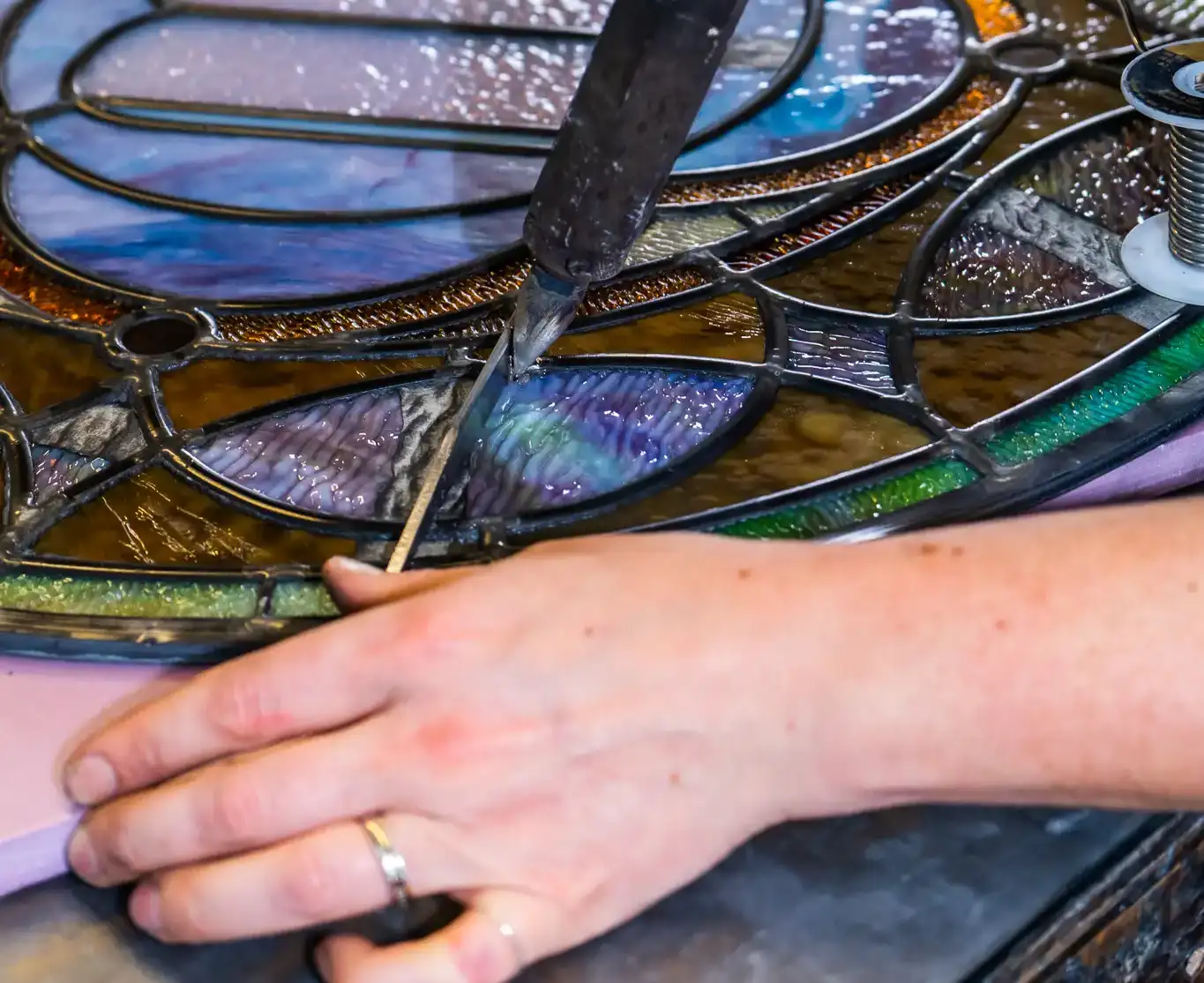
Preventative Measures to Safeguard Stained Glass
Preserving and repairing antique stained glass windows requires a thoughtful and comprehensive approach. These irreplaceable works of art are not only visual masterpieces but also bearers of centuries-old craftsmanship, cultural narratives, and religious symbolism. Protecting them demands proactive strategies that balance historical authenticity with modern protective technologies. Below are the essential measures that organizations and individuals can take to ensure the longevity of these delicate treasures.
Scheduled Inspections
The first and most critical step in preserving stained glass is implementing a regular schedule of inspections. Routine evaluations, ideally conducted annually or after significant weather events, are imperative for identifying early signs of damage. The professionals at Willet Stained Glass Studios – who are equipped to detect issues such as bowing, cracked or corroded cames, loosened pieces of glass, and moisture infiltration – can perform these inspections at no cost. Documentation during these inspections is equally vital, creating a historical record of the windows’ condition over time. This enables antique stained glass preservationists to track changes, prioritize repairs, and assess the efficacy of previous conservation efforts. Without consistent scrutiny, minor issues can escalate to catastrophic damage, making regular inspections the foundation of any preventive strategy.
Cleaning and Maintenance
Accumulated dust, grime, and sediment can dull the brilliance of stained glass, obscuring its intricate designs and colors. Cleaning must be conducted with care to prevent inadvertent damage. A gentle approach is paramount – soft brushes, distilled water, and mild detergents are recommended to remove surface dirt without scratching the glass or destabilizing delicate painted details. Avoid harsh chemicals, abrasive materials, or high-pressure cleaning tools, all of which can compromise the integrity of the glass. It is worth noting that professional intervention is advisable for cleaning, as the trained conservators at Willet Stained Glass Studios can employ techniques both effective and non-invasive. Beyond just cleaning the glass, attention should also be given to cleaning frames and surrounding materials, as dirt accumulation can degrade structural supports over time.
Protective Glazing Solutions
One of the most effective ways to safeguard antique stained glass from environmental harm and vandalism – and future costly repairs – is through the installation of exterior protective glazing. These coverings function as a shield against UV rays, wind-blown debris, and physical impacts, thereby mitigating the wear and tear caused by environmental exposure. However, protective glazing systems must be implemented with careful planning to avoid unintended consequences. For instance, improper ventilation of these coverings can trap moisture, which promotes condensation and accelerates the deterioration of both the glass and cames. Specialized, ventilated designs allow air circulation while maintaining the necessary barrier against external threats. Clear, non-reflective materials are often preferred for protective glazing, ensuring the aesthetic appeal of stained glass remains undiminished.
Frame Stabilization and Restoration
The structural integrity of stained glass windows relies not only on the glass itself but also on the surrounding frames and support systems. Neglected or deteriorating wooden or metal frames can pose serious risks, as weakened materials lead to unnecessary strain on the delicate stained glass components. Skilled craftsmen should conduct frame restoration or replacement to maintain historical authenticity. Where possible, modern reinforcements can be subtly integrated without detracting from the window’s original character. Weatherproofing vulnerable frame elements is also essential to prevent water infiltration and reduce the risk of rot or corrosion. Properly supported antique stained glass is less likely to experience movement, reducing the likelihood of stress fractures or misalignment and reducing the need for future repairs.
Environmental Control
Controlling the internal environment of the building housing stained glass plays a significant role in safeguarding these treasures. Consistent temperature and humidity levels help reduce the physical stress caused by thermal expansion and contraction. Installing humidity controls, dehumidifiers, or even low-energy heating systems in areas surrounding stained glass windows can mitigate the effects of adverse environmental conditions. Limiting direct sunlight through the use of interior UV films or shading elements may further protect against color fading while preventing heat buildup near the glass. A thoughtful environmental control strategy creates a stable atmosphere that minimizes wear and tear over time.
Professional Antique Stained Glass Repair When Necessary
Despite rigorous preventive measures, certain damage or degradation may require intervention beyond typical care. Engaging Willet Stained Glass Studios for restoration and repair ensures that such interventions are performed with utmost precision and respect for the historical fabric of the antique stained glass. Antique stained glass restoration projects might include replacing damaged cames, consolidating weakened glass sections, retouching painted designs, or repairing worn protective barriers. Our efforts are guided by a foundational principle of reversibility, where possible, ensuring future generations can make informed decisions about additional conservation work. Our specialist knowledge and antique stained glass and the use of appropriate materials are essential during restoration, allowing for repairs that remain both functional and true to the original craftsmanship.
Education and Advocacy
Finally, ensuring the long-term survival of stained glass windows rests on fostering widespread awareness and appreciation of their value. Educational programs for church staff, caretakers, and the community can help prevent well-meaning but damaging acts, such as improper cleaning of antique stained glass or attempts at amateur repairs. Advocacy for funding and resources dedicated to stained glass preservation can lead to stronger preservation efforts on both local and national levels. By instilling a shared responsibility for these remarkable works of art, we can inspire collective efforts to protect them.
Through these proactive measures – grounded in careful planning, skilled intervention, and a reverence for historical artistry – it is possible to preserve the timeless beauty and cultural significance of stained glass windows for generations to come.
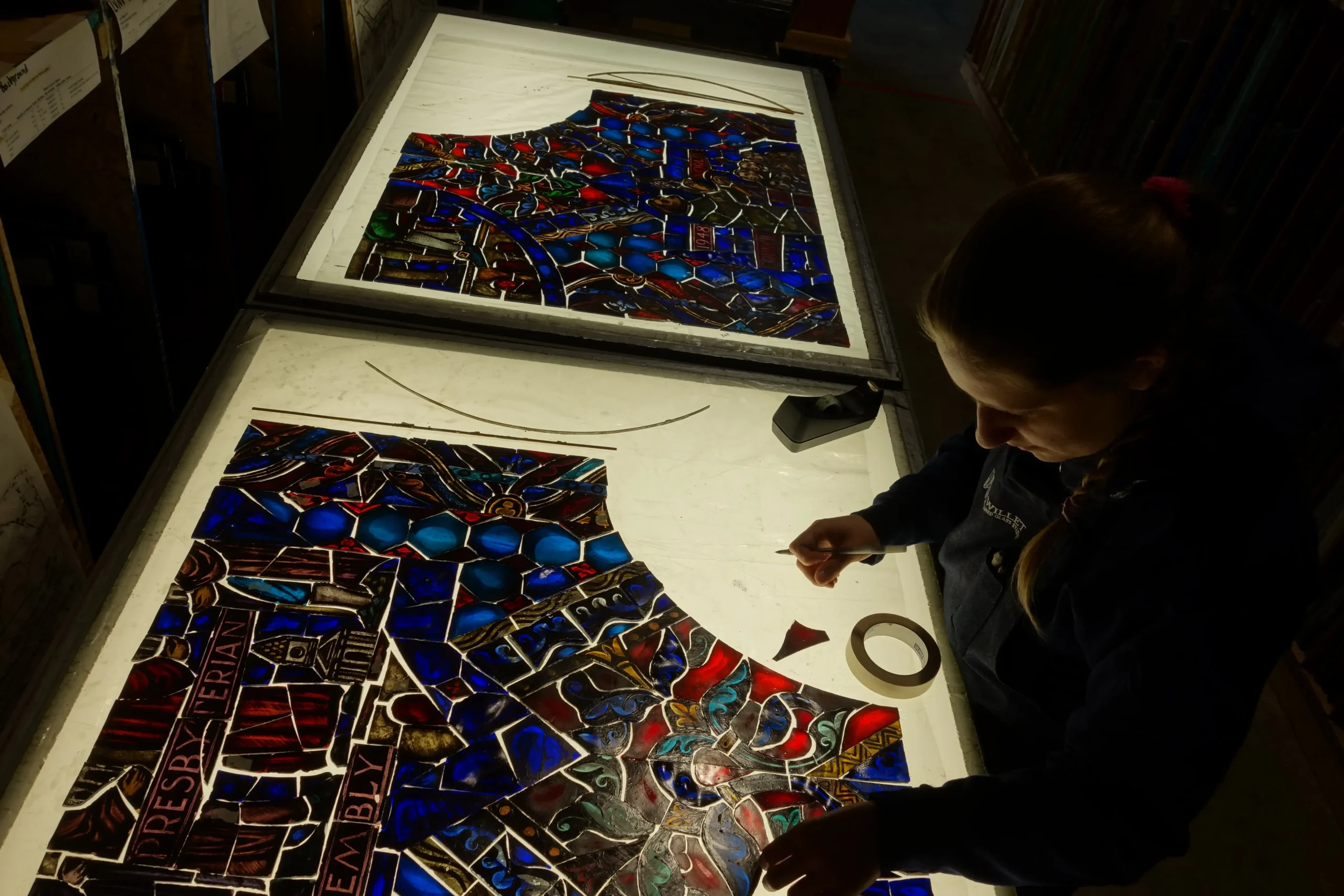
Restoration vs. Replacement: Ethical Considerations
When faced with aging or damaged antique stained glass windows, the decision between repair and replacement is highly significant. This choice encompasses not only practical outcomes but also critical ethical, historical, and artistic considerations. Churches, community leaders, and preservationists must act as stewards of the cultural and spiritual heritage embodied in these remarkable works of art, ensuring that any intervention aligns with the principles of conservation and respect for the craftsmanship of past generations.
The Case for Restoration
Restoration remains the gold standard for conserving stained glass, as it prioritizes the integrity of original materials and honors the intent of the artists who created these masterpieces. The process involves carefully assessing the window’s condition to determine the most appropriate, minimally invasive interventions. Common antique stained glass restoration techniques include the soldering of broken joints, the realignment of misaligned panes, the replacement of missing or irreparably damaged glass pieces with carefully chosen replicas, and the repair or reinforcement of lead cames. Each of these techniques is executed with the utmost precision to retain the historical and aesthetic integrity of the artwork.
Critically, restoration avoids unnecessary alteration, preserving the unique craftsmanship and character of the stained glass. The patina of age, brushstrokes of hand-painted details, and nuances in the coloration of antique glass are all elements that cannot be recreated authentically in modern replicas. Furthermore, restoration enhances the structural stability of the window while mitigating potential risks from environmental or structural stressors. By preserving these fragile works, restoration ensures that they continue to inspire awe and spiritual reflection for future generations.
Beyond the technical aspects, restoration and repair also acknowledge the cultural responsibility of preserving heritage, as each antique stained glass window is not simply a decoration but a repository of stories, artistic achievement, and religious devotion. Its survival connects contemporary viewers to the people and values of the past, making restoration a bridge between eras, allowing the perpetuation of cultural identity and collective memory.
Avoiding Replacement
The alternative to repair and restoration – replacement – should be approached with great caution and used only in cases where the existing antique stained glass is too damaged to feasibly preserve. Replacement often results in the loss of historical authenticity, diminishing the cultural and spiritual significance of the artwork. While modern replicas can be visually impressive, they lack the unique qualities intrinsic to historic stained glass, such as the depth of hand-blown glass textures, the subtle imperfections of medieval craftsmanship, and the irreplaceable patina achieved through decades or even centuries of exposure.
Replacing antique windows with modern counterparts risks turning sacred and historical spaces into facsimiles of their former selves, disassociating them from the timeline of their cultural evolution. Buildings with rich legacies, such as churches or historic public structures, rely on their artistic elements to convey their historical narrative. Each stained glass window is a chapter in that narrative, and replacing it outright effectively erases part of that story.
Ethically, replacement can also set a precedent that undervalues preservation efforts, normalizing the loss of ancient works in favor of convenience or cost reduction. This not only compromises the cultural landscape but also diminishes the collective commitment to safeguarding history. Advocating for and implementing restoration over replacement sends a powerful message about the value placed on heritage and artistry.
The Importance of Expert Craftsmanship
Whether restoration and repair or, in rare cases, replacement is chosen for your antique stained glass windows, the involvement of master artisans and conservators is paramount. Willet Stained Glass Studios offers unmatched expertise, ensuring that interventions maintain fidelity to the original piece while adapting to modern conservation needs. When restoration is the chosen route, the process is undertaken with meticulous care, preserving every detail of craftsmanship. For unavoidable replacements, these studios produce windows that honor the spirit of the originals, though they must always be marked or documented to distinguish them from authentic historic works.
Balancing Values
Ultimately, the decision to restore or replace is not only a technical one but also a deeply ethical choice. The intrinsic value of historic stained glass goes beyond its physical and aesthetic aspects. It serves as an enduring symbol of artistry, faith, and cultural unity. By choosing restoration where feasible, church and community leaders demonstrate their commitment to stewardship, entrusting these treasures to caretakers who will respect and uphold their legacy.
Partnering with expert studios, engaging stakeholders, and fostering a shared sense of responsibility ensures that the decision aligns with the historical, architectural, and spiritual importance of these irreplaceable works. Restoring rather than replacing stained glass preserves its essence and ensures that these magnificent windows continue to illuminate spaces with their timeless beauty for centuries to come.
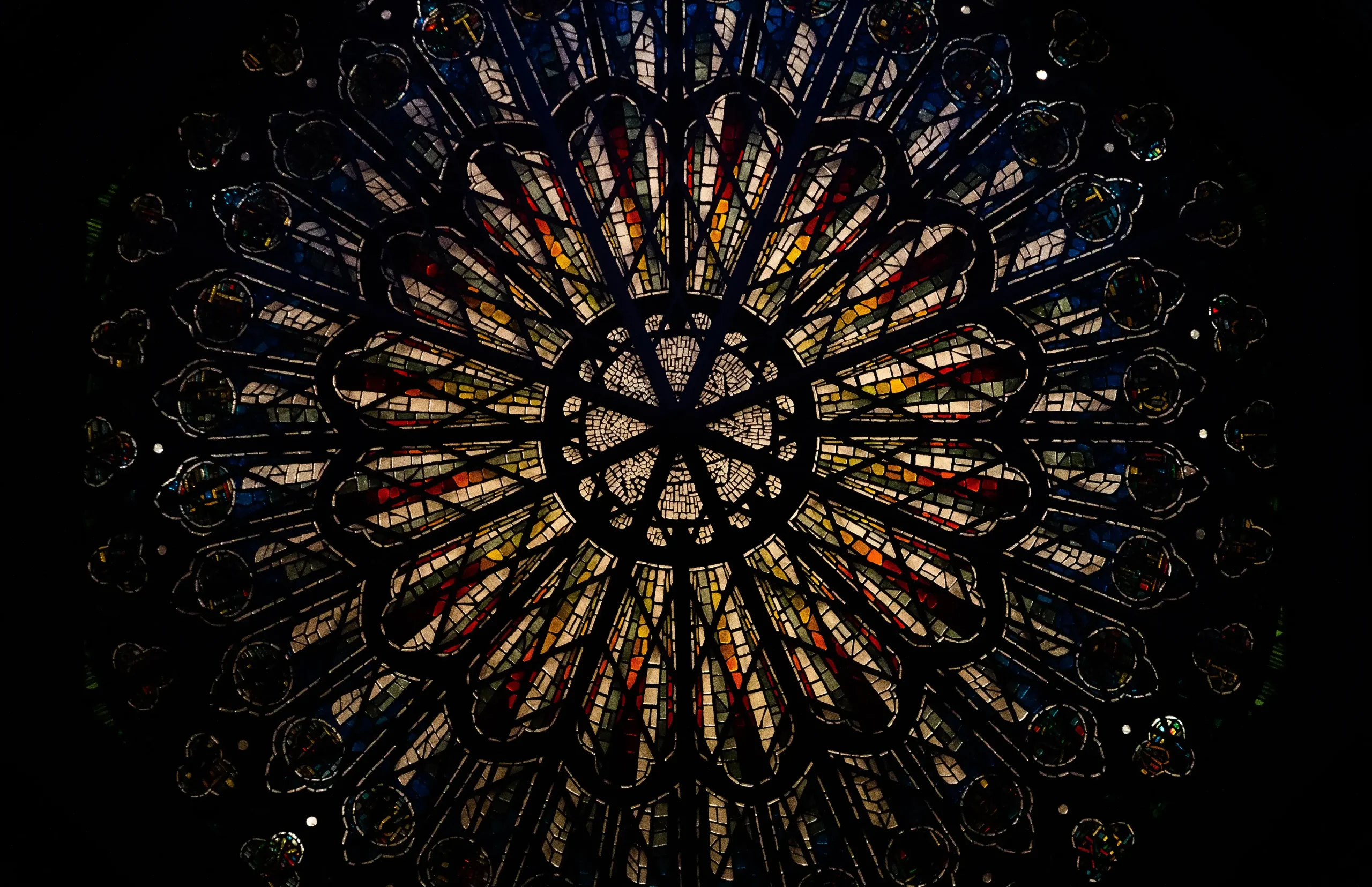
Funding and Resources for Preservation
Preserving and repairing antique stained glass is undoubtedly a substantial financial commitment, yet the investment is critical to safeguarding these irreplaceable works of art and heritage. Thankfully, a variety of funding sources and support networks are available to assist churches, civic organizations, and preservationists in their efforts to maintain and restore stained glass windows. Understanding and navigating these options is key to ensuring successful preservation projects and the eternal survival of these cultural treasures.
Grants and Financial Aid
A number of national and international organizations recognize the cultural and historic value of stained glass and offer financial support for its preservation. The National Fund for Sacred Places is one such organization, providing targeted grants to houses of worship looking to restore and preserve their historic features, including stained glass windows. Similarly, the Getty Foundation offers grants through its Conserving Modern Architecture Initiative, which, while primarily focused on modern works, also extends funding to stained glass projects that align with its objectives.
Other programs such as the Save America’s Treasures grant, administered by the National Park Service in partnership with organizations including the National Endowment for the Humanities and the Institute of Museum and Library Services, offer substantial financial support to protect nationally significant artifacts and sites. Specific to religious institutions, the Partners for Sacred Places grants are designed to assist congregations in preserving the architectural and artistic integrity of their spaces. Regional and local grant programs may also be available depending on the location, providing additional opportunities for funding.
Churches, nonprofit organizations, and preservation societies are encouraged to research these programs thoroughly, understand application requirements, and present compelling cases for why their stained glass restoration project deserves support. Clear documentation of the historical and architectural significance of the windows, coupled with a detailed project plan and budget, greatly increases the likelihood of grant approval.
Donations and Fundraising Campaigns
While grants provide substantial assistance, they rarely cover the entire cost of preservation projects. For this reason, community-driven fundraising efforts are an essential supplement to external funding. Successful campaigns often involve both the congregation and the wider community, emphasizing the cultural and historical importance of the stained glass and its role as a shared legacy.
Innovative fundraising ideas include hosting tours of the church or building to showcase the stained glass, providing educational talks on its history, or even creating sponsorship opportunities where donors can “adopt” a pane or section of the window. Crowdfunding via online platforms can also extend outreach to a global audience, particularly appealing to those with personal or familial ties to the building. By leveraging social media and storytelling, churches and historic sites can highlight the urgency and importance of the restoration effort, building an emotional connection that resonates with potential donors.
Partnering with Conservation Experts
Beyond financial assistance, technical and strategic partnerships with conservation organizations play a vital role in stained glass preservation. Organizations such as the American Glass Guild and the Association for Preservation Technology provide invaluable resources, from professional consultation and technical expertise to educational programs for those undertaking restoration projects.
These organizations often maintain extensive networks of highly skilled artisans, conservators, and studios, connecting project leaders with the expertise needed for complex restorations. Leveraging these networks not only ensures access to master craftsmen but also reinforces credibility when applying for grants or soliciting donations – demonstrating a commitment to preserving the highest standards of craftsmanship and authenticity.
Tax Incentives and Other Benefits
Many projects benefit from tax incentives available for the preservation of historic properties. Federal tax credits such as those enacted under the Historic Tax Credit program can be applied to properties listed on or eligible for the National Register of Historic Places, further reducing the financial burden on owners or stakeholders. Additionally, state and local governments often provide similar benefits through property tax abatements or preservation-specific grants that encourage stewardship of historic architecture.
Church and building leaders contemplating preservation work should consult with tax professionals and historic preservation specialists to fully understand and take advantage of these incentives. Explaining these potential financial benefits to donors and stakeholders can also strengthen their commitment to supporting the project.
Building a Long-Term Preservation Strategy
Preservation is not merely a one-time effort but an ongoing responsibility, making long-term planning essential for success. Establishing a dedicated maintenance and preservation fund ensures that resources will be available for future needs. Recurring donations, endowments, or legacy giving initiatives can help sustain these funds over time, providing financial stability and continuity.
By incorporating restoration and conservation into a broader stewardship plan, organizations demonstrate a deep respect for their cultural heritage and encourage stakeholders to view preservation as a shared, continuous effort. Engaging congregations, communities, and experts alike helps foster a culture of collective responsibility and pride in maintaining the stained glass windows for generations to come.
Supporting the Legacy of Stained Glass
Through a combination of financial aid, community involvement, and expert guidance, historic stained glass windows can be preserved and celebrated as enduring testaments to artistry and faith. Churches, preservationists, and community leaders are urged to utilize the resources available to them, not only to restore these treasures but to ensure that their legacy endures. By approaching preservation projects with thoughtful planning and a sense of shared purpose, we underscore the immense value of these works and their unparalleled ability to illuminate our history – in both a literal and figurative sense.

Partnering with Willet Stained Glass Studios
When it comes to preserving and repairing antique stained glass, expertise matters. Willet Stained Glass Studios has been a leading force in the art of stained glass for more than 125 years. With a track record of restoring iconic landmarks such as the National Cathedral in Washington, D.C., and Grace Cathedral in San Francisco, our craftsmanship speaks for itself.
Our skilled team offers comprehensive restoration services, from detailed appraisals to intricate repairs of antique stained glass. Using time-tested techniques, supported by state-of-the-art facilities, we ensure your windows are not only preserved but revitalized.
Ultimately, antique stained glass windows are more than decorative elements; they embody faith, history, and artistry. By understanding the threats they face, implementing preventative measures, and working with the skilled artisans at Willet Stained Glass Studios, you can ensure their brilliance continues to illuminate sacred spaces for generations to come.
Take the first step today. Contact Willet Stained Glass Studios for a free inspection and expert appraisal. Together, we can preserve the beauty and heritage of stained glass.
Interested in restoring or enhancing your church’s windows?
Contact Willet Stained Glass Studios today for a free inspection and consultation. Our team is here to help you protect and revitalize your stained glass while honoring its heritage and artistry.







